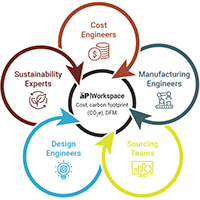December 14, 2023
AI-Powered Product Design

Transcript
How to design Artificial Intelligence for product design
The rise of AI-driven modeling tools has some people in manufacturing scrambling to understand the impact of artificial intelligence and wondering how the product design process will change as a result.
Over the past year we have seen in real-time user-friendly AI tools such as ChatGPT from OpenAI and AI image generation from midjourney disrupt the markets for graphic design, web design, and social media content creation. Is product design and manufacturing prototyping the next in line for AI-powered disruption?
Today I’m excited to talk to one of the early founders of AI technology, CEO of Fire & Spark, Dale Bertrand. Dale was a pioneer in Artificial Intelligence research at Brown University where he also trained as an electrical engineer. His experience using AI to solve engineering problems puts him into a unique position to understand how AI design tools for manufactured products might be changing the workflow for design engineers and even the scope of design projects in manufacturing today.
I wanted to get a sense from Dale Bertrand based on his experience both in the AI field and in the engineering field, whether the innovations we are seeing today in generative AI and machine learning have any real bearing on the way products will be designed and manufactured in the future. I started our conversation by listing some of the AI innovations I’ve seen transform the creative process in other industries, and asking whether these digital products have any bearing on the future of manufacturing.
Leah Archibald to Dale Bertrand: I think we’d wanna have a free flowing conversation about how AI is going to impact manufacturing specifically. And I would love to think more about in terms of product design, ’cause we have a sense of, okay, technology and manufacturing, like we know what’s happening on assembly lines, there are robots, blah, blah blah. But I’m interested in how is product design going to change as more product designers get more tools to accelerate their job? How is it going to change work for design engineers?
Generative AI for the design process
Dale Bertrand: You really have to think about it at a higher level. We have Generative AI that will help us to design things. When I was working as an electrical engineer, I would be designing layouts for a PCB or something like that. Generative AI can help us to create these initial designs. But then we’ll also have Predictive AI, which will help us make better real-time decisions. When I was electrical engineer, these decisions would be choosing how much current we need to be able to support with a particular component. To protect against various anomalies that might happen electrically. So that would be predictive AI.
But there is another side of it where Generative AI and Predictive AI come together. And that’s in the workflow of how teams work together. Today as part of the creative process, teams can collaborate by using AI as a sounding board for ideas, or using artificial intelligence to help with project management around product design teams.
So I feel like the way that people interact and collaborate will change dramatically with AI. And what I’m really curious about, since I worked for many years as an engineer, is — will the engineers that I worked with — will they be some of the first people to adopt these AI tools?
Leah Archibald: Or the last?
Dale Bertrand: That’s what I want to know. Because I consider myself very technologically forward. I am somebody who adopts the best AI tools because I think it’s interesting and I want to benefit from new tools as quickly as possible. But I also know that when I was working in an engineering environment, things can move slowly. My job as an engineer was to be conservative so that things worked. Because we had to make sure that the final product was fault-tolerant and we could drop it from 5 feet and have it not break the prototype on the very first drop test. We were paid to be conservative. But when it comes to these AI tools, there’s so much promise there. And perhaps the benefit has less to do with product design and more to do with how engineering teams work together.
ChatGPT, what is Generative vs Predictive AI?
Leah Archibald: Sometimes when you talk to an AI chat bot like ChatGPT, you say, “Explain this to me as if I was a high school student.” So I wonder if you pretend you’re ChatGPT and explain to me as if I was a high school student the difference between Generative AI and Predictive AI, especially in terms of how you think they’re going be used in the product design process.
Dale Bertrand: When we’re talking about Generative AI versus Predictive AI, one example of Generative AI is large language models, like those made by OpenAI and midjourney. These are basically some really smart software that can understand natural language. And that’s proven to be very useful for a lot of tasks, like interfacing with the software that we use every day but in a more user-friendly way. In terms of product design, Generative AI or a large language models can understand prompts or instructions that an engineer would give a design tool. So instead of rotating and exploding various assemblies or models that I have my model, I could talk to the tool, describe to it what I want, and have it understand my instructions and actually do it. So it’s called Generative AI because a lot of times we’re using it to generate either a text or audio or video or CAD design.
I’ll give you an example from when I was in grad school studying Artificial Intelligence. We had a CPU that we were designing, and there was just one instruction that would go off the rails if it had been proceeded by a number of instructions in a specific order before it. So there was this statistical probability that this one instruction would give the wrong result, but we didn’t know exactly what that sequence of instructions was because it was probabilistic. So what I did was run a number of different instructions randomly, with hundreds of instructions proceeding this instruction. At that point, we knew we had the problem that sometimes the issue would pop up, and sometimes it wouldn’t pop up. But the simulation generated a vast amount of data that we could have an AI tool look at and make some predictions around what instructions might be interacting with this instruction that’s having a problem. So that’s one way that we used Predictive AI, which was basically predicting which instructions were interacting with this instruction that was giving us a problem.
On the side of generative AI, when I’m writing code for a CPU that we designed, I can use a large language model to generate the code. So language doesn’t just mean English, it could also mean a computer language.
Leah Archibald: A coding language.
Dale Bertrand: Yes. Which is what I use AI-powered tools for now. There are so many applications for using a generative AI large language model for coding, I do this every day. I’ll describe to large language model what I want the code to do, the code that I need. Or I’ll give it code that’s not working, and ask it to debug that code for me.
Often in product design, you’re going to have libraries of data sheets for all the components that you might need. That’s just a massive amount of data. So I’ll give the large language model a whole bunch of data sheets and start asking questions. What might go wrong in this system? And with electrical systems, there are all kinds of things that can go wrong if you pair the wrong components together. The large language model can understand that because it can understand data sheets and it can also understand the engineering and electronics that go behind it.
How can the best AI tools streamline product design?
Leah Archibald: So I’m hearing here that AI technology can bring huge productivity boosts for individual engineers operating within the individual scope of their work. But now let’s talk about workflow and teams. How can the best AI tools streamline collaboration in product design?
Dale Bertrand: It depends on the size of the team you work on. At the low end of that, if it’s like eight people working together, what you could imagine is that these teams are having design meetings, code reviews, things like that. And these are meetings, maybe they’re remote, maybe they’re in person, but with AI they can be recorded and the AI can automatically identify what’s been decided, what is still contentious, what tasks have been assigned, and who they’ve been assigned to, and then also what issues were raised and never resolved. And having an AI automatically send out those bullet points at the end of design meeting is hugely helpful. Because the alternative to that is either we’re all taking notes, and maybe we have different notes, or maybe we have a project manager in the meeting that is or isn’t capturing high-quality feedback.
And then when we get into much bigger design projects, there are some very huge systems that could require hundreds, thousands of engineers to get together to design the final product. Then we’re talking about many, many different meetings coordinated between multiple project managers, and there are so many things that can fall through the cracks. And we all know we don’t have somebody on the payroll to read the transcript of that meeting that happened on Wednesday with the electronics group, and then also read the transcript of the meeting that happened with the product design team and make sure that there weren’t any conflicting decisions made. Nobody’s doing that. But we can have instant AI-generated summaries automatically.
Leah Archibald: What I’m hearing from you is that the tasks that we’re already doing, but doing poorly, these are the ones that are rife for automation.
Dale Bertrand: Yes. And it really helps to take a structured approach to it.
With any project we’re working on, at any organization we’re working at, we are going to have goals. To meet these goals, we are going to come up with strategies to get there. We create the digital product twin first. We ask suppliers to make a prototype — we send out requests for pricing. In order to get through the design process on time and on budget, we want to sprinkle in AI technology to help us reach these goals. And the reason why I’m talking from a goals perspective is because we want to make sure that we take this business impact first approach. Rather than saying, “We have these cool tools that we want to play with, let’s figure out what they’re good for.” Then we find a bunch of things that using AI can do, but half of them aren’t saving us the time that we would hope, or they’re not helping us get to a high-quality output. So instead we look at the goals that we already have, they might be business-level initiatives or problems that we’re trying to solve on our product teams, and then from there figure out how can we apply the best AI tools to help us make an impact.
When using AI for design projects, think business first, tool second
Leah Archibald: I think this is my biggest takeaway from this conversation: when we talk about an AI-powered design process, even if it’s the best AI tools that you’re using, it still needs to be business first, tool second. This is really the order that all software procurement should take. But in our collective excitement over AI, it’s often not happening. So we need to go back to the question: what is the business problem we’re trying to solve? And then how can we use the best AI tools to solve the problem that has primacy?
Dale Bertrand: That’s exactly right. So if you were to look across all of the problems, all of the areas you would love to impact, some of them are going to be more impactful than others if you were to solve them. Applying AI technology to these areas in an intelligent way would have a huge impact. Compared with some other things, like improving our grammar in our internal emails.
Leah Archibald: Dale, this has been a super helpful conversation. I’m glad to sit across the table from a real human expert who understands AI technology. Thank you so much.
Dale Bertrand: Thanks for having me.








